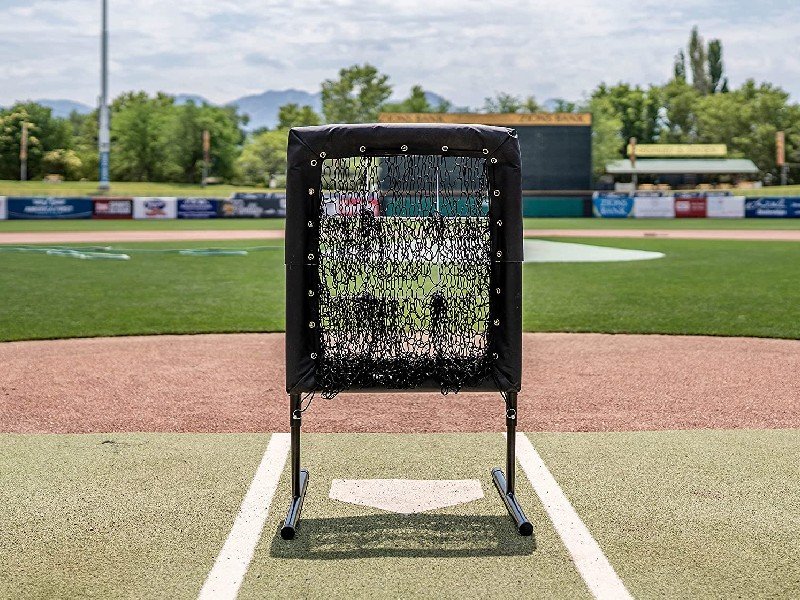Baseball and softball pitch back nets provide pitchers and fielders with the capacity to do solo training drills. In addition, these baseball throwing nets can act as a pitching target or a baseball bounce-back net. As a result, baseball and softball pitch back nets are one of the must-haves in your training arsenal.
What are Pitch Back Nets?

Due to a baseball’s construction, it doesn’t bounce similarly to tennis balls. As a result, this limits the training possibilities for fielders trying to improve their fielding skills. Therefore, fielders and pitchers utilize baseball and softball pitch back nets in their training sessions.
Baseball and softball pitch back nets, as the name implies, rebound the ball back to the thrower. By utilizing an elastic net, a rebounder net helps mirror the ball’s force, mimicking a pass in the process. Consequently, this allows users to train their fielding on their own or under the supervision of a baseball coach.
Furthermore, baseball and softball pitch back nets provide various uses, making them excellent as baseball coach gear. In addition, pitch back nets offer versatility in terms of their use because of their adjustable angle. Thus, allowing users to field grounders, line drives, and flyballs through its various settings.
The Different Uses of Softball and Baseball Bounce Back Net
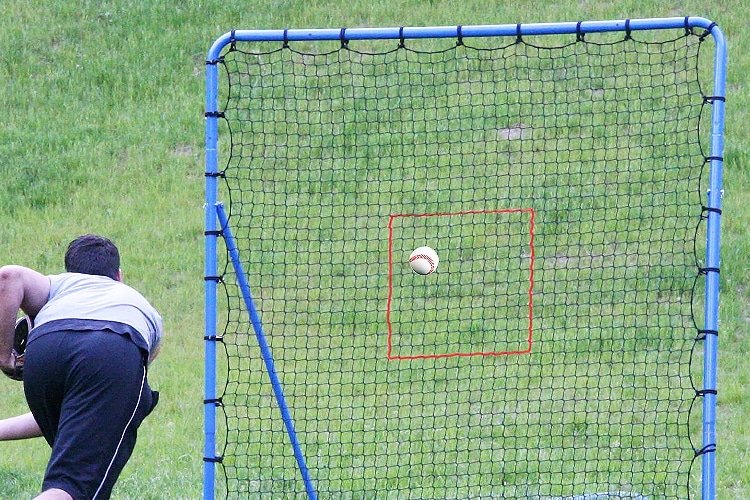
- Grounder Fielding Training
- Line Drive Fielding Training
- Flyball Fielding Training
- Pitching Target
As stated, a baseball and softball bounce back net or rebounder utilizes elastic nets to rebound the ball. As a result, this emulates a trampoline-like effect wherein the net sends back the ball in different trajectories depending on the net’s angle.
Furthermore, coaches and players can utilize baseball bounce back nets in their fielding training sessions. By adjusting the angle of bounce-back nets, players can adjust the trajectory of the ball’s rebound. Consequently, allowing them to train three types of ball trajectories— grounders, line drives, and flyballs.
Grounder Fielding Training
As we know, fielders require specific steps to properly field groundballs in both baseball and softball games. By nature, grounders are fast and easy to field; however, players must still follow specific steps when fielding groundballs. For instance, players must round on the baseball from the right to harness enough momentum to throw it to the first base.
Therefore, by aligning baseball and softball pitch back nets on a 90°, they return balls at an angle that resembles grounders. Consequently, players can repeatedly practice their form when fielding grounders for more efficient movement and ball transfers.
Line Drive Fielding Training
In baseball and softball, a line drive is a sharp ball trajectory— usually at an angle between 10-25°. Usually, line drives occur when batters hit a baseball or softball excellently. Line drives can reach whopping speeds, which may prove dangerous to fielders who don’t how to field this trajectory type.
Therefore, coaches make their players utilize the best infield gloves and outfielder gloves for faster ball transfers and efficient fielding. Even so, the best baseball gloves would only do so much if a player doesn’t have the intent of tackling line drives. Thus, by placing the angle of a rebounder around 50° to 60°, players can train their reaction time and fielding technique. Lastly, this technique provides players with enough experience and muscle memory training to protect their chest against line drives.
Flyball Fielding Training
In the outfield, an outfielder’s job is crucial, especially when attempting to catch a flyball to generate an out. Here is where flyball fielding training comes in. Aside from getting the best baseball gloves for outfielders, outfielders must familiarize themselves with the mechanics and muscle memory required. From peeping on their glove’s webbing to executing the proper flyball fielding technique, an outfielder must come prepared in games.
Thus, coaches or self-training baseball athletes can utilize a baseball and softball pitch back net in their flyball fielding training. By throwing a ball at pitch back net around 40° to 30°, players can emulate flyballs for their fielding training.
Pitching Target

Some manufacturers incorporate a strike zone on their rebounder net. Thus, helping baseball and softball pitch back nets work as a pitching target for pitching training. Of course, nothing beats an original baseball pitching net when it comes to target practice. However, baseball and softball pitch back nets beat the former in terms of versatility.
For instance, a baseball rebounder net can accommodate the needs of infielders for a grounder and line-drive fielding. In addition, users can also set up rebounder nets for flyball outfield fielding sessions. Lastly, the use of baseball and softball pitch back nets as pitching targets are only suitable for both pitchers and fielders.
On the other hand, in comparison, baseball pitching nets are only ideal for pitching and batting training. This type of baseball throwing net acts as a ball organizer as it cushions the ball’s impact, offering no-ball rebound in the process.
Nevertheless, both net types work as a pitching target and excel in their use. Therefore, if you are looking to improve your pitching and fielding skills, then we suggest you opt for a pitch back net for pitching targets. Conversely, for batters and pitchers, we suggest a plain-old baseball pitching net.
What to Look for When Buying Pitch Back Nets— A Buyer’s Guide
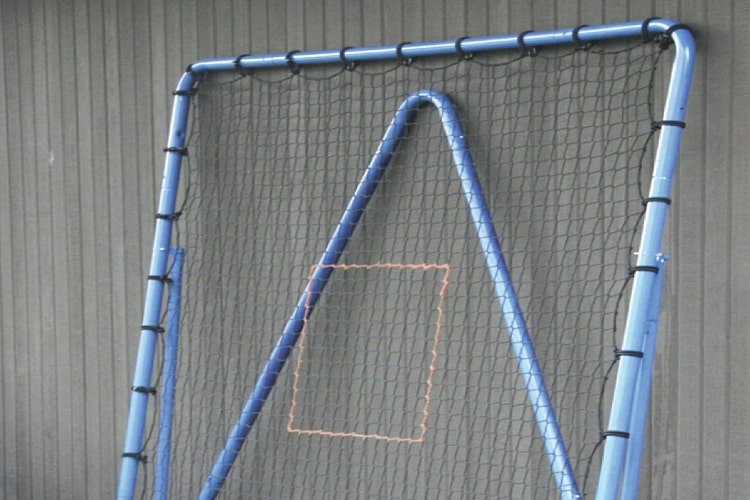
Now we have enumerated the different uses of baseball and softball pitch back nets, let’s move on to our buyer’s guide. On paper, the performance and benefits pitch back nets provide are excellent for both pitchers and fielders. However, to benefit from this, buyers must know the things to consider when buying pitch-back nets. Doing so allows buyers to ensure that the product they are getting will perform optimally.
Without further ado, here are the various things to look for when buying pitch-back nets:
- Durability and Structure Stability
- Adjustable Angle
- Strike Zone Marker
- Portability
Durability and Structure Stability
Before buying a pitch-back net, buyers must first ensure its durability. For example, buyers should look for heavy-duty rebounder nets that feature durable nets and materials. Some excellent materials to look for are steel construction frames and thick flexible nets.
Moreover, buyers should also look for weatherproof materials such as rust-proof frames and waterproof nets. Doing so eliminates the need for buyers to store their pitch back nets, especially if they are using them for backyard training sessions.
Furthermore, buyers should ensure that the rebound net they are buying features a stable base. This ensures that the pitch back net can efficiently return the ball to the pitcher without losing much force. Some manufacturers utilize a stake to keep their product from moving upon ball contact. Meanwhile, some manufacturers construct their heavy-duty rebound net with enough weight to keep it stable.
However, when purchasing heavy-duty pitch back nets, the more robust you go, the less portable it becomes. Still, investing in a durable product saves money, especially if they only plan to use their rebound net for home practice.
- Steel frame
- Thick and flexible pitch back nets
- Rust-proof frame
- Weatherproof nets
- Stable base
Adjustable Angle
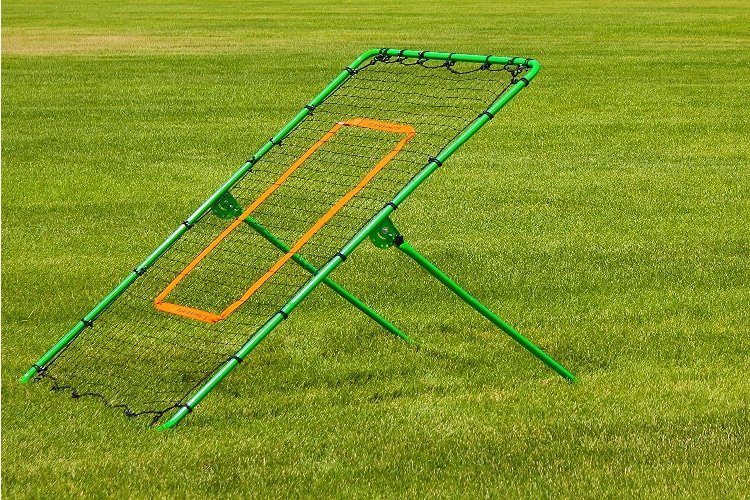
To utilize rebounder nets for a grounder, line drive, and flyball training, buyers should look for nets with adjustable angles. Ideally, rebounder nets should feature at least three-angle settings.
For grounders, a pitch back net should be able to adjust its angle to 90°. Through this setting, rebounded balls will take a trajectory down the ground before it reaches the thrower. For line drives, a rebounder angle between 50° and 60° will suffice. Lastly, a rebounder net can generate a flyball by adjusting to an angle of around 40° and 30°.
- 3 rebounder angle settings
- 90° angle for grounder fielding training
- 50° and 60° for line drive fielding training
- 40° and 30° for flyball fielding training
Strike Zone Marker
For pitching and accuracy training, a strike zone or pitching target is an excellent optional accessory for your rebounder net. To save money, buyers should opt for pitch back nets that include a built-in strike zone marker. However, they can still find attachable aftermarket strike zone markers for their existing pitch back nets.
- Built-in strike zone markers
- Aftermarket strike zone markers
Portability
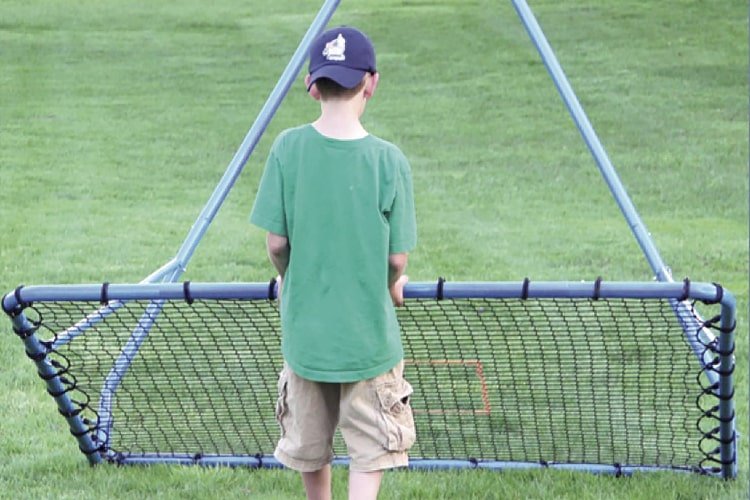
One of the most important aspects of rebounder nets is their portability. In addition, portable nets are easier to transport and store in comparison with heavy-duty rebounder nets. Therefore, we advise buyers to look for lightweight pitch-back nets that don’t compromise durability. Some excellent materials for this are hollow steel frames, synthetic materials, and nylon nets.
Furthermore, for maximum portability, we suggest buyers look for rebounder nets that feature a quick setup and teardown. In this light, the product can provide users with easy storage within minutes! In addition, this construction style helps rebounder nets to fit in the best baseball bags or provided carrying cases.
- Quick setup and teardown time
- Lightweight construction
- Hollow Steel Frame Material
- Lightweight Synthetic Materials
- Nylon nets
Frequently Asked Questions about Baseball and Softball Rebounder Nets
Q: What is a rebound net?
Baseball and softball pitch back nets a.k.a. rebounder nets are suitable for pitching and fielding training sessions. Since baseballs don’t bounce naturally, fielders utilize rebounder nets to practice their fielding on their own. Some adjustable rebound nets offer fielding training for a grounder, line drive, and flyball trajectories.
Q: Can you use a rebounder for football?
Yes, football players can utilize baseball and softball pitch back nets. Designed for baseball and softball, pitch back nets can accommodate tennis balls, footballs, and other balls for solo training.
Q: Do rebound nets work?
Yes, rebound nets provide players with ample training to familiarize themselves with the movement necessary for fielding. In addition, rebound nets allow players to practice fielding on their own or under the supervision of a coach. Nevertheless, rebound nets get the job done, especially for fielding training sessions.
Q: How do you make a rebounder?
Making a rebounder net is a tedious process. Considering that you have to make an adjustable angle frame and portable construction, it can prove to be tedious. Therefore, we advise buyers to buy durable rebounder nets instead.
However, if you want to cut on your spending, here is an easy and low-cost idea for a rebounder net:







